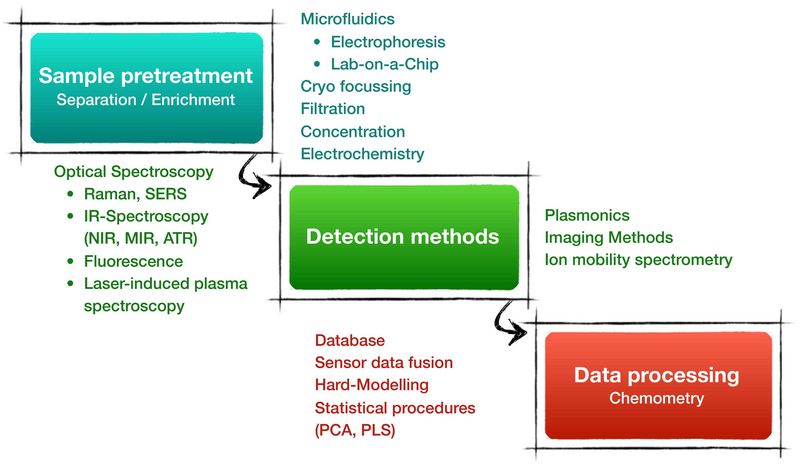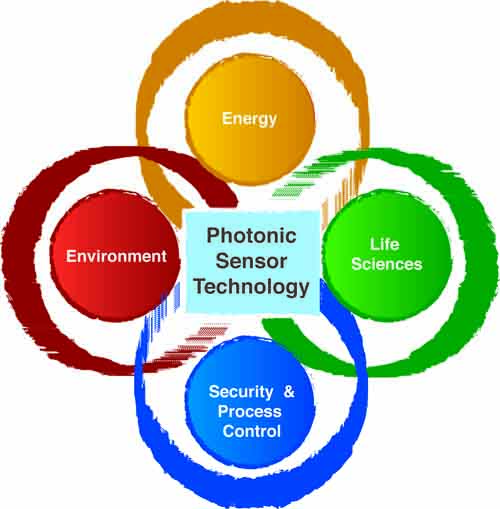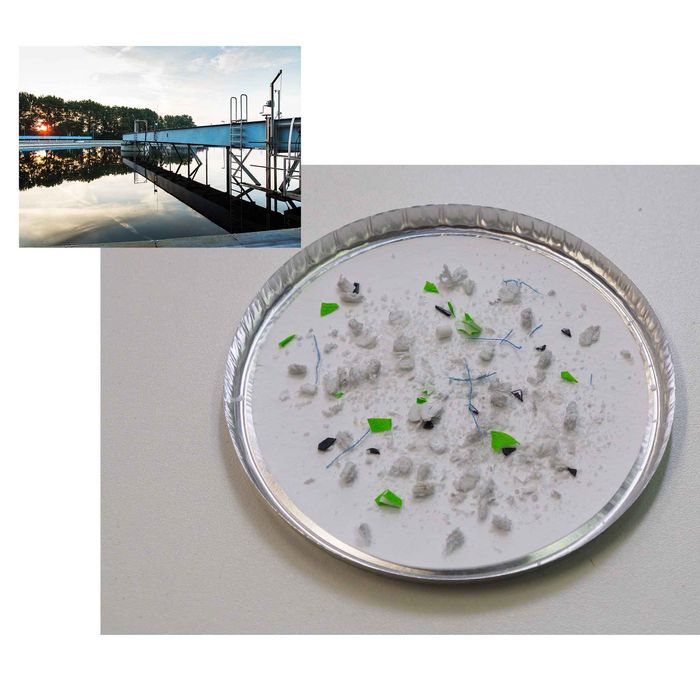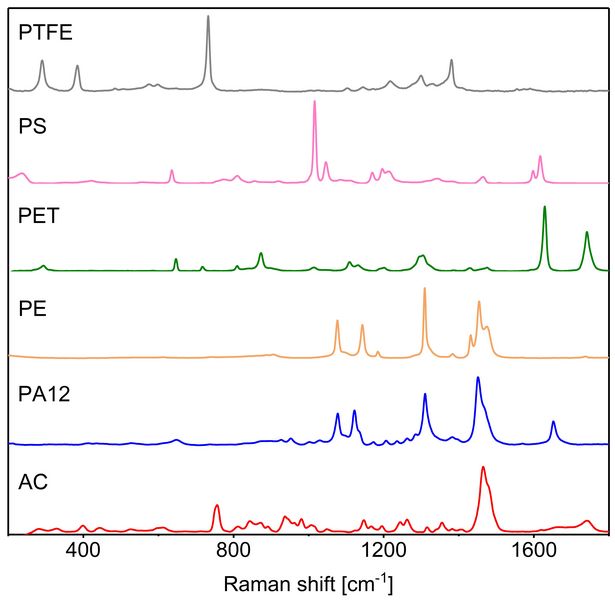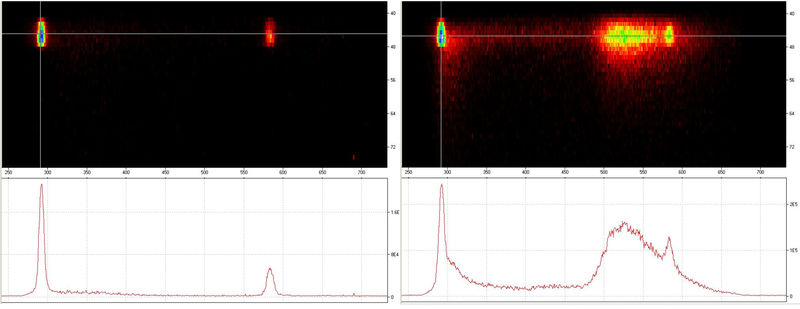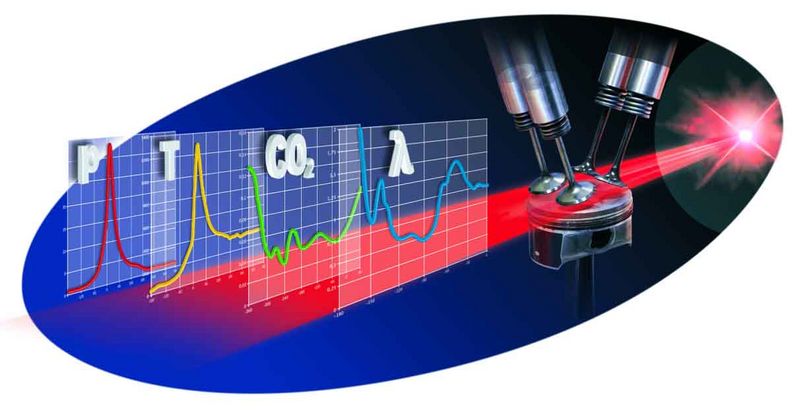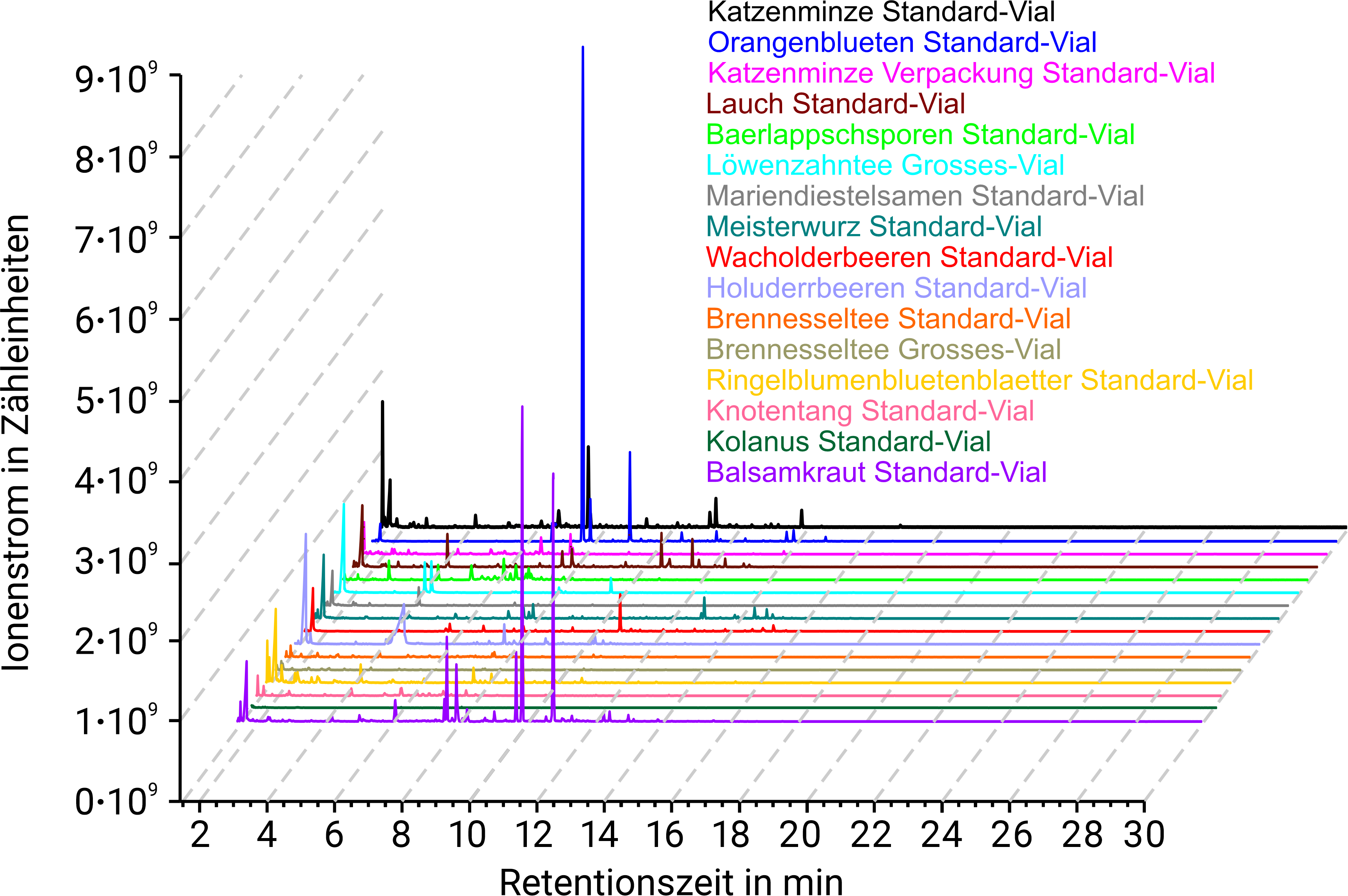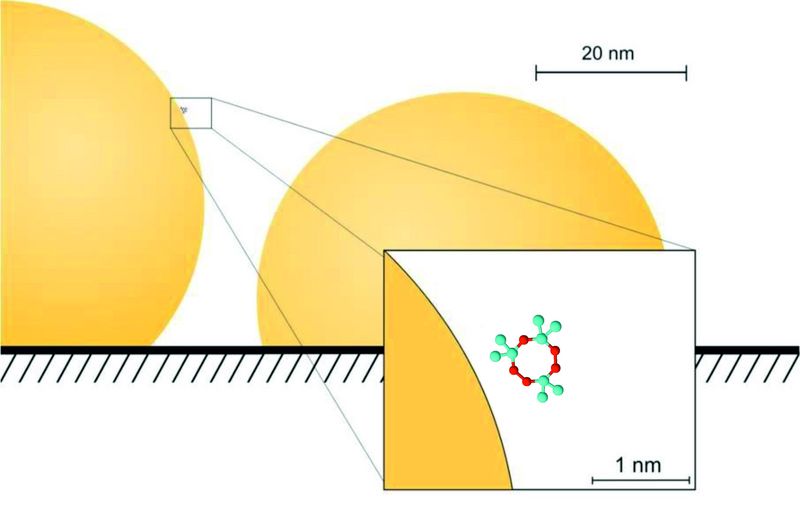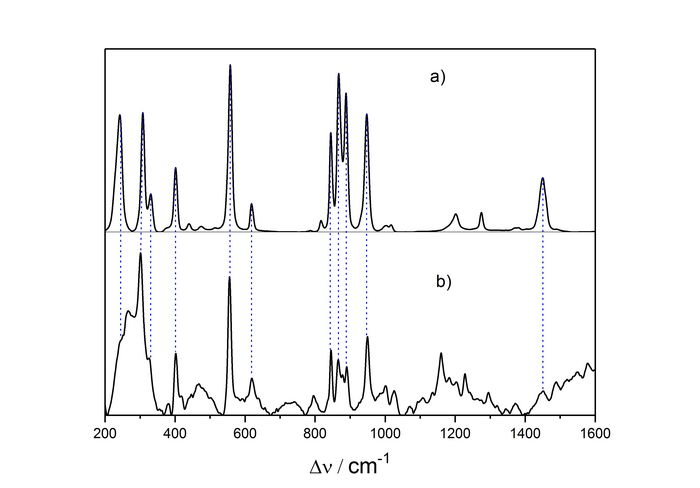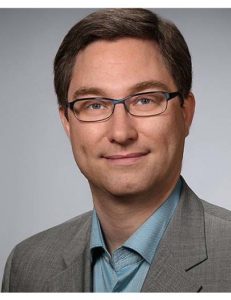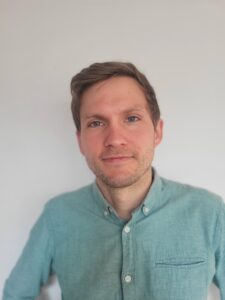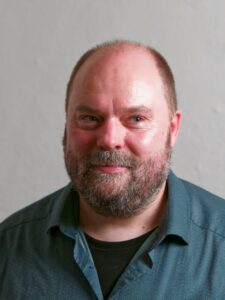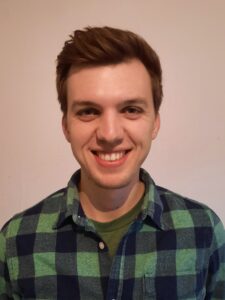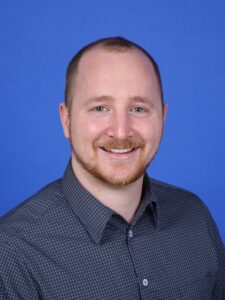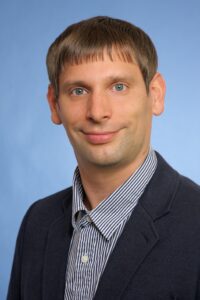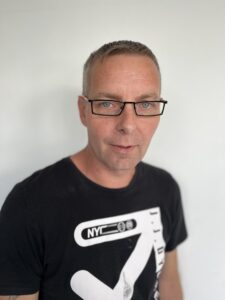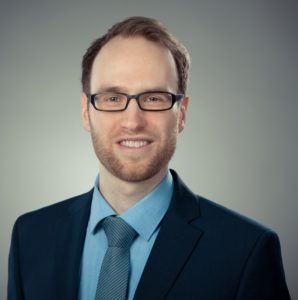The Department of Photonic Sensor Technology deals with a variety of physico-chemical, mostly light-based, analysis techniques in science, environment, and industry. Using optical methods, being inherently fast and non-invasive, measurement data can be recorded quickly, contact-free, and thus non-destructive. For this reason, optical methods are already the basis for analytical investigations in research laboratories in chemistry, medicine, materials science, engineering, and biotechnology. The department sees thus a central challenge in further developing and implementing optical analysis techniques in industrial processes and applications outside of research laboratories.
Numerous problems are so complex that they cannot be answered on the basis of a single optical technique. The Photonic Sensor Technology department therefore develops system solutions that consist of a combination of different optical techniques or a combination of optical techniques with other technologies. Thus, the photonic sensor technology department relies on the development of novel optical measurement methods, mainly based on:
- Raman spectroscopy
- IR-absorption spectroscopy
- Fluorescence
In addition, the department has expertise in a complementary method, the ion mobility spectrometry (IMS), which can also be used in, e.g., trace analysis. Moreover, the department explores the possibility of integrated systems. The studies may include thereby following steps:
- Sample pretreatment (separation, enrichment)
- Detection by means of different (optical) sensors
- Data processing (chemometric data analysis, sensor data fusion).
This enables the Photonic Sensor Technology department to manage complex processes and to develop systems that combine different analytical methods. The main challenges that are thereby tackled are measurement speed, selectivity, and sensitivity.
Environment
Aufgrund des gewachsenen Umweltbewusstseins der Gesellschaft werden neue gesetzliche Vorschriften bezüglich Verwendung und Emission von Schadstoffen und der Vorgabe neuer Grenzwerte erlassen. Diese sind ein Antrieb neue Verfahren für die Vor-Ort-Analytik zu erforschen.
Due to society’s growing environmental awareness, new legal regulations regarding the use and emission of pollutants and the specification of new emission limit values are issued. The latter is a driving force for us to explore new methods for on-site analytics.
In the field of gas analysis, for example, the concentration of carbon dioxide and carbon oxide in exhaust gases as well as volatile organic compounds in industrial production processes are investigated.
The contamination of water with microplastics and pharmaceutical residues as well as soils with polyaromatic hydrocarbons (PAH) are further topics with a high socio-economic impact.
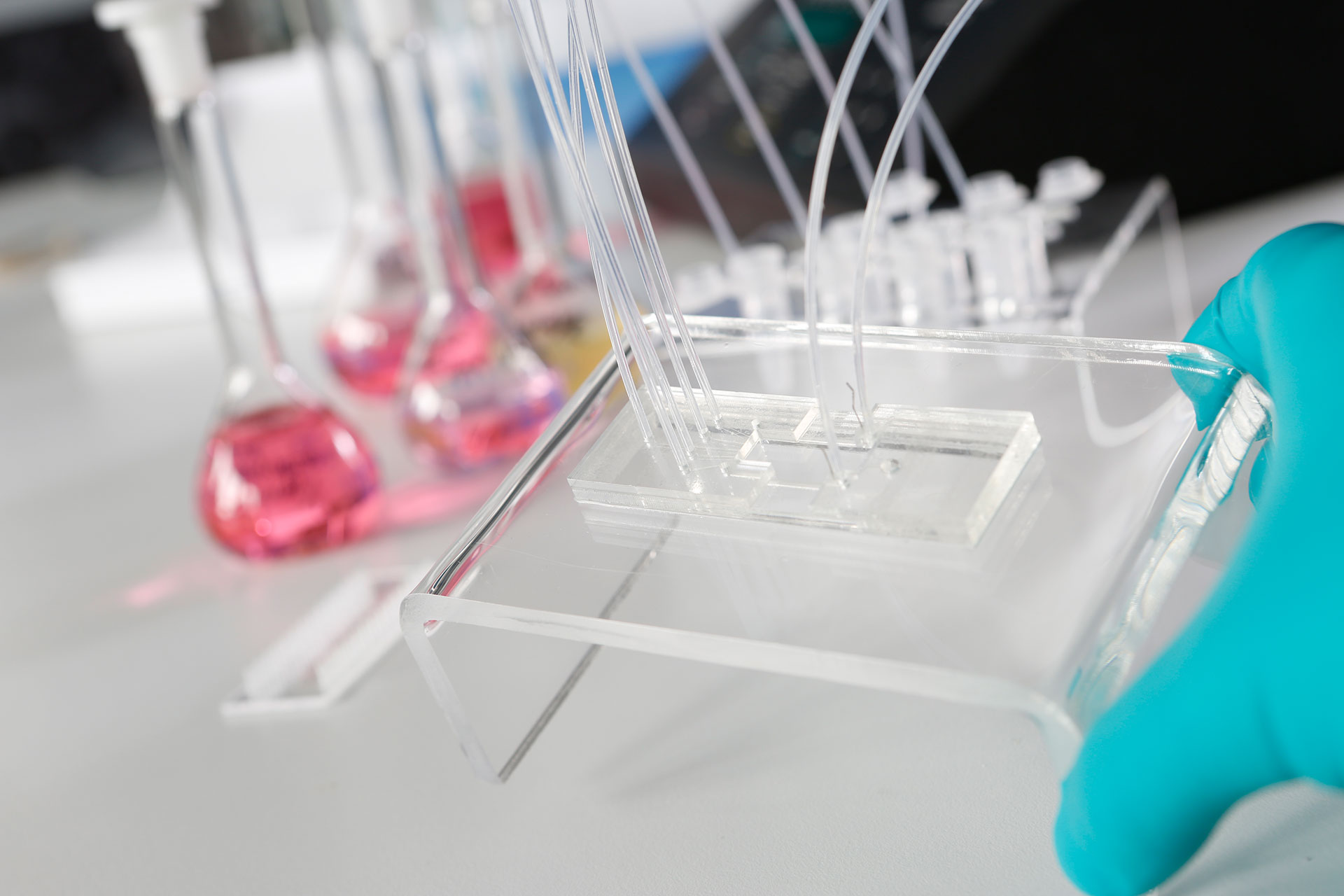
Non-dispersive IR-absorption for emission testing
In 2016, there were approximately 13 million gas boilers, 5.6 million oil heating boilers, and 0.7 million boilers for burning solid materials in Germany. Furthermore, there were approximately 11.7 million fireplaces or tile ovens which operated with either wood or coal. The resulting exhaust gases from these combustion processes affect the environment, climate, and health, and therefore are governed by federal regulations, as stated in the Federal Emissions Protection Regulation for small- and medium-sized firing systems.
To control these regulations, a chimney sweep measures the relevant parameters such as carbon monoxide (CO) and oxygen (O2) every two years. For these monitoring measurements, electrochemical sensors are used, which are liable to frequent inspections as well as heavy wear due to their construction. Furthermore, the greenhouse gas and main combustion product carbon dioxide (CO2) is not detected with electrochemical sensors. Its concentration is determined through CO and O2 measurement, resulting in an error for the calculation of the emission.
The goal of our work in collaboration with Vereta GmbH is the development of an optical sensor that can simultaneously measure the concentration of CO and CO2 in the exhaust gas of a firing system.
Non-dispersive infrared spectroscopy (NDIR) is used as the measurement technique. With the help of the Beer-Lambert law, the concentration of the gases in the exhaust gas flow can be determined. Working at the mid-infrared regime has the advantage of large absorption cross sections and small overlap of the absorption bands of CO2 and CO.
The construction of the optical set-up of the sensor is subject to the constraints of compactness, robustness, as well as low cost. Simultaneously, the system has to match requirements of high measurement accuracy, which requires a high signal-to-noise ratio and, in the case of CO, requires a long absorption distance. This conflict of the demands is a challenge for the development of such sensors.
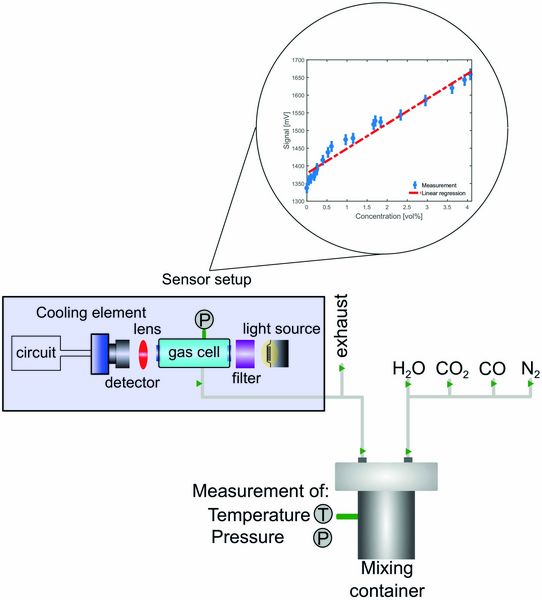
Schematic of the sensor setup. Left: The sensor based on NDIR spectroscopy is shown. The test gases with known concentrations are prepared in the mixing chamber. Inset: Measurement for CO. The sensor shows a linear behavior on the concentration.
Microplastics in sewage
In recent years, public attention is increasingly focussed on the topic of microplastic residues in water bodies. The reason for this is that the load on surface waters continues to rise and microplastics are detected in an increasing number of organisms of the food chain, which are also partly used for human consumption. The resulting health risks have not been explored yet. Methods for the enrichment and analysis of microplastic particles are neither standardized nor applicable for on-site analysis.
The aim of our work is the research and development of a practical on-site method for determining the mass of microplastic particles directly on filters. This method of determination is to be used in the monitoring of the effluent of sewage treatment plants.
The Raman method used is based on the scanning of the filter by means of a process Raman device. Therefore, no particles are counted but an average spectrum of all the particles present on the filter and the filter material are generated. The counting of individual particles and the Raman spectroscopic analysis of these particles requires the high apparatus-complexity of a Raman microscope, which is not practical in process analysis. Since the Raman spectrum of the loaded filter contains contribution from the Raman spectra of all substances on the filter and the filter material itself, a mathematical separation is necessary. For this purpose, the mathematical statistical method of partial least squares regression (PLS) is tested. A major challenge still remaining is to analyse and compensate the effects caused by the sample matrix.
Laser-induced fluorescence for PAH determination
Over the last decade, our team developed different versions of a transportable UV-laser-fluorimeter with fibre optical probe for use in environmental and process analysis.
As light source a short-pulse up-converted diode-pumped Nd:YAG-laser with emission at 266 nm is used. The wavelength is perfect for the excitation of mono- (BTXE) and polycyclic aromatic hydrocarbons (PAH), as well as humic substances, aromatic amino acids and proteins.
Deploying optical waveguides out of quartz, the laser pulse is flexible guided to the measurement place for the excitation and the fluorescent emission is then guided back to the detection unit. Due to the special geometry of the fibres in the probe, the emission is collected efficiently and the entry of directed stray light is minimized.
The detection was implemented in different ways:
Time-dependent sequential, lifetime-resolved detection:
The fluorescence emission is spectrally fragmented and the spectra are detected at different times after the excitation pulse is emitted with a gated, intensified CCD-camera. Out of the obtained data, the spectrometer software builds up an emission-decay-spectrum.
Wavelength-dependent sequential, lifetime-resolved detection:
By applying a monochromator, a single emission wavelength can be chosen for which a high temporal resolved fluorescence decay curve can be detected. This is possible in deploying a time-correlated single photon counting technique. Out of several decay curves the software builds up an emission-decay-spectrum.
Integral fluorescence detection:
In combination with a diode line or CCD line array, the full fluorescence emission spectrum can be obtained. This setup is used, if the fluorescence decay times in the application are shorter than the decay of the instrument response function.
The control of all system versions is implemented with a self-developed spectrometer software. Furthermore, with this software a qualitative and quantitative data evaluation is feasible that ranges from simple linear one-component-regression over decay-time analysis to complex multi-component-analysis by deploying chemometric methods.
For feasibility studies the laserfluorimeters are placed at interested party’s disposal.
Further information
Non-dispersive IR-absorption for emission testing
C. Niklas, Quantification of CO2 and CO concentrations via non-dispersive infrared spectroscopy, Master thesis, University of Göttingen and LLG, 18. July 2018.
Laser-induced fluorescence for PAH determination
F. Lewitzka, M. Niederkrüger, G. Marowsky:
„Application of Two-Dimensional LIF for the Analysis of Aromatic Molecules in water”, in P. Hering, J.P. Lay, S. Strey (Editors): „Laser in Environmental and Life Sciences”, 141-161, Springer Verlag, Berlin, 2003.
P. Karlitschek, F. Lewitzka, U. Bünting, M. Niederkrüger, G. Marowsky:
„Detection of aromatic pollutants in the environment using UV-laser-induced fluorescence“, Appl. Phys. B 67, 497-504, 1998
Funding:
DBU-Förderung „Entwicklung eines Laserfluorimeters zum Nachweis von organischen Schadstoffen in Wasser“ (1994-1996, Förderkennzeichen 01989).
BMBF-Förderprogramm Mikrosystemtechnik „BTXE und PAK Sensor“ (1996-1999, Förderkennzeichen 16SV558/0).
BMBF-Förderprogramm Mikrosystemtechnik „BTXE und PAK Sensor II“ (1999-2003, Förderkennzeichen 16SV1112/5).
Energy
The research of energy conversion processes has been studied at the Laser Laboratory since its founding. Imaging techniques such as laser-induced fluorescence are used for mixture analysis of fuels inside the combustion chamber of internal combustion engines. A spark plug sensor based on non-dispersive IR absorption has been intensively investigated and developed further.
With it the concentration of liquid and gaseous fuel at the location of the spark plug can be determined. In addition to propulsion systems based on fossil fuels, the department is also engaged in the research of Li-ion batteries based on optical technologies.
Exhaust gas sensor for IC engines
A new European Union (EU) regulation on the control of CO2 emissions requires reducing the average emissions of new cars below 95 g/km by 2021. The use of compressed natural gas (CNG) as fuel allows significant reduction of the CO2 emissions and thus achieves the goal set by the EU.
The development of efficient and low-emission CNG-engines is a new challenge since the physical properties of CNG differ significantly from those of conventional liquid gasoline. This directly influences the mixture formation and the combustion process. Therefore, the time-resolved (100 μs) acquisition of data on the gas density of each substance (methane, water and carbon dioxide) involved in a motorcycle of a typical four-stroke engine is urgently required.
The department Photonic Sensor Technology established a collaboration with the Institute for Com-bustion and Gasdynamics Duisburg and the companies LaVision GmbH and Volkswagen AG on the solution to this problem in the OMeGa-E project ending in mid-2017.
During former projects, a spark-plug sensor based on IR-absorption to measure mixture formation in the combustion chamber of an engine was developed together with LaVision. This sensor was further developed in the OMeGa-E project for use with CNG air mixtures.
The results on a test engine at Volkswagen and a rapid compression machine at University Erlangen showed the functionality of the developed ICOS system. Based on this successful development, a commercial sensor is produced and sold by LaVision, with which CNG engines can be optimized and hence be manufactured more environmentally friendly.
Measuring the density of CO2 and the lambda value together with pressure and temperature during an engine cycle give the possibility of an extensive analysis of the mixture formation. (source: LaVision GmbH)
Further information
Exhaust gas sensor for IC engines
P. Kranz, D. Fuhrmann, M. Goschütz, S. Kaiser, S. Bauke, K. Golibrzuch, H. Wackerbarth, P. Kawelke, J. Luciani, L. Beckmann, J. Zachow, M. Schuette, O. Thiele, T. Berg:
In-cylinder LIF imaging, IR-absorption point measurements, and a CFD simulation to evaluate mixture formation in a CNG-fueled engine, SAE Technical Paper 2018, 2018-01-0633, 2018.
S. Bauke, K. Golibrzuch, H. Wackerbarth, P. Fendt, L. Zigan, S. Seefeldt, O. Thiele, T. Berg:
Optical sensor system for time-resolved quantification of methane concentrations: validation measurements in a rapid compression machine, Journal of Quantitative Spectroscopy & Radiative Transfer, 210, 101-110, 2018.
K. Golibrzuch, F.-E. Digulla, S. Bauke, H. Wackerbarth, O. Thiele, T. Berg:
Optical sensor system for time resolved quantification of methane densities in CH4-fueled spark ignition engines, Applied Optics, 56 (22), 6049-6058, 2017.
S. Bauke, K. Golibrzuch, F. Rotter, H. Wackerbarth, O. Thiele, T. Berg:
Quantitative, time-resolved detection of CH4 concentrations in flows for injection analysis in CNG engines using IR absorption, Journal of Sensors and Sensor Systems, 6 (1), 185-198, 2017.
A. Grosch, H. Wackerbarth, O. Thiele, T. Berg, L. Beckmann:
Infrared spectroscopic concentration measurements of carbon dioxide and gaseous water in harsh environments with a fiber optical sensor by using the HITEMP database, Journal of Quantitative Spectroscopy & Radiative Transfer, 133, 106-116, 2014.
A. Grosch, V. Beushausen, H. Wackerbarth, O. Thiele, T. Berg, R. Grzeszik:
Calibration of mid-infrared transmission measurements for hydrocarbon detection and propane concentration measurements in harsh environments by using a fiber optical sensor, Journal of Quantitative Spectroscopy & Radiative Transfer, 112 (6), 994-1004, 2011.
Life Science
Life sciences are research directions that deal with processes or structures of living beings or in which living things are involved. For the department, the study of methods for medical diagnosis, the monitoring of biotechnological processes, and food research are the main fields of interest. In this respect, microfluidics as a sample preparation technology has proven to be effective. Here, a miniaturized free-flow electrophoresis chip for the separation of proteins with an optical read-out mechanism was explored.
Furthermore, a lateral flow test for veterinary medicine is being investigated. With it, cytokine detection in very low quantities is possible. The test is thereby based on surface-enhanced Raman spectroscopy. In the field of medical technology, we investigate the possibilities of a photonic sensor for the monitoring of infusion solutions on patients.
Inactivation of microorganisms on bulk materials
Manufacturers and suppliers of natural-based herbs, teas and spices, i.e. so-called organic products, often struggle with contamination from tiny or microorganisms such as fungi and bacteria or mites. These undesirable organisms damage the quality of the products and represent a health risk for the end customer as well as a reduction in shelf life. This is particularly true if multiplication occurs. Reducing these organisms can help. The methods used so far, such as steam or CO2 treatment, are inadequate or not suitable. Compatible with natural raw materials is inactivation by UV light or the still little-researched use of plasmas. The reaction mechanisms that result from such inactivation in connection with organic substances are partly known, but the specific impact on the products is not. This is where a project comes into play in which the IFNANO is responsible for examining such bioproducts before and after the microorganisms are deactivated by plasma or UV radiation. Gas chromatographic techniques will be used, as well as semiconductor sensors that can describe the outgassing behavior of the bioproducts. In addition, photographic processes including hyperspectral analysis should be used.
The work on this topic is co-financed by the state of Lower Saxony and supported by the European Union within the framework of an innovation project, for which we would like to thank you. The innovation project began on August 1, 2023 and will last 3 years. Funding as part of the European Innovation Partnership Agri supports cooperative innovation projects that provide impetus for a competitive, sustainable food industry. The aim is to promote innovation and improve the exchange of knowledge between science and agricultural practice.
- please refer to the website of our partner
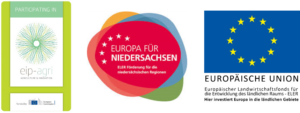
Miniturized chip for free-flow-electrophoresis
For the detection and quantitative analysis of liquid mixture ingredients, for monitoring chemical and biological production and purification processes as well as for analytical procedures in medical diagnostics, the department Photonic Sensor Technology has developed a continuous online analysis and monitoring process. The current focus lies in the monitoring of protein production for pharmaceutical applications.
The method is based on the coupling of free-flow electrophoresis (µFFE), in which the components of a complex liquid mixture are separated, and an optical detection system, such as fluorescence or surface-enhanced Raman scattering (SERS). The detection system is highly sensitive and is used for the identification of the different molecular species being separated and enriched by µFFE.
The miniaturization of the FFE system has some advantages. In particular, μFFE-systems require only a few nanoliters to microliters of a sample, which makes the application in clinical analysis or protein production, where only small amounts of samples are available, particularly interesting. Another important advantage of miniaturization is the avoidance of heating due to the otherwise occurring high electrical currents. The chip is produced and sold by microfluidic ChipShop.
Further information
Miniturized chip for free-flow-electrophoresis
Walowski, B., Hüttner, W., Wackerbarth, H., Generation of a miniaturized free-flow electrophoresis chip based on a multi-lamination technique—isoelectric focusing of proteins and a single-stranded DNA fragment, Analytical and Bioanalytical Chemistry, 401, 2465-2471, 2011.
Hüttner, W., Christou, K., Göhmann, A., Beushausen, V., Wackerbarth, H., Implementation of substrates for surface-enhanced Raman spectroscopy for continuous analysis in an optofluidic device, Microfluid Nanofluid, 12 (1-4), 521-527, 2012.
Security and Process control
The objective of our research in the security sector is to protect people from the threats of natural disasters, major accidents, and terrorism. In the field of safety engineering, we are investigating new detection methods for explosives, thus making controls at, e.g., airports more reliable and effective. Another challenge is the chemical assessment of the state of health of ammunition in the sea.
Process control requires fast, non-destructive, selective, and sensitive measurement procedures. The processes should be robust, low-maintenance, and inexpensive. Optical methods are in principle very well suited for this.
Examples of this are the determination of moisture in matrices such as coffee using near-infrared spectroscopy and chemometry and the development of a device for the quantification of bitter substances in beers by means of absorbance measurement. These requirements are also met by ion mobility spectrometry, which has been researched and implemented for the monitoring of formaldehyde concentration in the production of wood-based materials.
Detection of explosives
Explosive detection is an actual and pressing issue. Surface enhanced Raman scattering (SERS) spectroscopy enables rapid, faultless detection of different classes of explosives including triacetone triperoxide (TATP). This explosive was, for example, used in the attacks in Paris in November 2015.
Traces of explosives on clothing or luggage are picked up with a fleece by means of the so-called wiping test. The fleece is heated to analyse the vaporizable components. The low amounts of the substances are a great challenge for Raman spectroscopy, which is as characteristic as a fingerprint.
The principle of thermal deposition is used to gather the explosive molecules on the plasmonic substrate. For this purpose, the nanostructured surface is located on a cooling finger. On to this, the substances to be analyzed, which have been baked out of the fleece by means of the thermal desorption unit, are redeposited in a minimal area. This process is also referred to as cryofocusing.
Further information
Explosive detection
H. Wackerbarth, C. Lenth, S. Funke, L. Gundrum, F. Rotter, F. Büttner, J. Hagemann, M. Wellhausen, U. Plachetka, C. Moormann, C. Strube, A. Walte:
Surface enhanced vibrational spectroscopy for the detection of explosives, Proc. SPIE, 8896, art. no. 889609, 2013.
H. Wackerbarth, L. Gundrum, C. Salb, K. Christou, W. Viöl:
Challenge of false alarms in nitroaromatic explosive detection—a detection device based on surface-enhanced Raman spectroscopy, Applied Optics, 49 (23) 4367-4371, 2010.
H. Wackerbarth, C. Salb, L. Gundrum, M. Niederkrüger, K. Christou, V. Beushausen, W. Viöl:
Detection of explosives based on surface-enhanced Raman spectroscopy, Applied Optics, 49 (23) 4362-4366, 2010.
Plasmonic substrates
J. Barnett, U. Plachetka, C. Nowak, H. Wackerbarth:
Highly periodic Au nano-disc arrays for plasmon resonance-controlled SERS structures on fused silica using UV-NIL based double-layer lift-off process, Microelectronic Engineering, 172, 45-48, 2017.
S. Funke, H. Wackerbarth:
The role of the dielectric environment in surface enhanced Raman scattering on the detection of a 4-Nitrothiophenol monolayer, J. Raman Spectrosc., 44 (7), 1010-1013 2013.
K. Christou, I. Knorr, J. Ihlemann, H. Wackerbarth, V. Beushausen:
Fabrication and Characterization of Homogeneous SERS-Substrates by Single Pulse UV-Laser Treatment of Gold and Silver Films, Langmuir, 26 (23), 18564-18569, 2010.
Products and services
- Are you searching for solutions for measurement problems?
- Do you wish for a service provider that converts your budget for research and development reliably to customer-oriented solutions?
- Do you have an urgent need for a prototype built specifically for your requirements?
The physicists, chemists and engineers in our team hold extensive knowledge, competence and technical abilities in the field of optical sensing and place it at your disposal. We are very experienced in the fields of industrial research and development.
We would be pleased to advise and accompany you in the whole process of finding, from general consulting in measurement techniques, the elaboration of feasibility studies over performing of on-site measurement campaigns and leasing of special, client-specific measurement equipment to the development of measurement techniques and prototypes.
Our team is ready for every challenge.
Contact us!
We are looking forward to develop customized solutions for your problems.
Contact person:
Head of Department
Dr. Hainer Wackerbarth
“Photonic Sensor Technologies”
Tel.: +49(0)551/5035-58
Fax: +49(0)551/5035-99
hainer.wackerbarth@ifnano.de
Staff members
Head of department
E-Mail: hainer.wackerbarth@ifnano.de
Tel.: +49 551 5035-58
Staff member
E-Mail: georgios.ctistis@ifnano.de
Tel.: +49 551 5035-27
Publications
Publications
- C. Niklas, G. Ctistis, F. Müller, H. Wackerbarth:
Ramanspektroskopie mit photonischen Hohlkernfasern am Beispiel atmosphärischer Gase, Sensoren und Messsysteme 2019, Nürnberg, Deutschland (06.2019) - C. Lenth, F. Wieduwilt, G. Ctistis, J. Banett, U. Plachetka, H. Wackerbarth:
Vor-Ort-Analytik von 1-H-Benzotriazol auf Basis der oberflächenverstärkten Raman-Spektroskopie, ANAKON 2019, Münster, Deutschland (03.2019) - H. Wackerbarth:
Raman-basierte Techniken im Bereich Patientensicherheit und medizinischer Diagnostik, 12. Workshop Kleine Volumenströme in der Medizintechnik, Lübeck, (06. 2019) - G. Ctistis, C. Niklas, F. Müller, and H. Wackerbarth:
Quantitative measurement of CO with non-dispersive infrared absorption spectroscopy, DPG-Frühjahrstagung 2019, Rostock, Deutschland (03.2019) - F. Wieduwilt, C. Lenth, U. Plachetka, H. Wackerbarth:
Detektion von Arzneimitteln in Abwässern durch oberflächenverstärkte Raman-Spektroskopie, ANAKON 2019, Münster, Deutschland (03.2019)
Publications
- S. Bauke, K. Golibrzuch, H. Wackerbarth, P. Fendt, L. Zigan, S. Seefeldt, O. Thiele, T. Berg:
Optical sensor system for time-resolved quantification of methane concentrations: validation measurements in a rapid compression machine, Journal of Quantitative Spectroscopy & Radiative Transfer, 210, 101-110, 2018. - P. Kranz, D. Fuhrmann, M. Goschütz, S. Kaiser, S. Bauke, K. Golibrzuch, H. Wackerbarth, P. Kawelke, J. Luciani, L. Beckmann, J. Zachow, M. Schuette, O. Thiele, T. Berg:
In-cylinder LIF imaging, IR-absorption point measurements, and a CFD simulation to evaluate mixture formation in a CNG-fueled engine, SAE Technical Paper 2018, 2018-01-0633, 2018. - C. Niklas, S. Bauke, G. Ctistis, K. Golibrzuch, H. Wackerbarth:
Non-dispersive IR-spectroscopy in harsh environments, Sensoren und Messsysteme 2018, Nürnberg, Deutschland (06.2018) - F. Wieduwilt, S. Göllner, G. Ctistis, C. Lenth, H. Wackerbarth:
Evaluation von plasmonischen Strukturen für die Detektion von Arzneimittelrückständen,
Umwelt 2018, Münster, Deutschland (09.2018) - F. Wieduwilt, C. Lenth, U. Plachetka, H. Wackerbarth:
Herstellung und Charakterisierung von funktionellen Oberflächen für die Bioanalytik,
19. Heiligenstädter Kolloquium, Heilbad Heiligenstadt, Deutschland (09.2018), ISBN 978-3-00-0606546-4 (2018) - F. Wieduwilt, C. Lenth, U. Plachetka, H. Wackerbarth:
SERS als Möglichkeit zur Überwachung von Oberflächenfunktionalisierungen, Kaiser-Friedrich-Forschungspreis, Goslar, Deutschland (10.2018)
Publications
- K. Golibrzuch, F.-E. Digulla, S. Bauke, H. Wackerbarth, O. Thiele, T. Berg:
Optical Sensor System for Time-Resolved Quantification of Methane Densities in Methane-fueled Spark Ignition Engines, Applied Optics, 56 (22), 6049-6058, (2017)
- J. Barnett, U. Plachetka, C. Nowak, H. Wackerbarth:
Highly periodic Au nano-disc arrays for plasmon-resonant SERS structures on fused silica using UV-NIL based double-layer lift-off process, Microelectronic Engineering, 172, 45-48 (2017)
- S. Bauke, K. Golibrzuch, F. Rotter, H. Wackerbarth, O. Thiele, T. Berg:
Quantitative, time-resolved detection of CH4 concentrations in flows for injection analysis in CNG engines using IR absorption, Journal of Sensors and Sensor Systems, 6(1), 185-198 (2017)
Conference constributions
- S. Bauke, K. Golibrzuch, H. Wackerbarth, O. Thiele, T. Berg:
Quantitative, Time-Resolved Detection of CH4 in Flows using IR Absorption, 18. GMA/ITG-Fachtagung Sensoren und Messsysteme 2016, doi: 10.5162/sensoren2016/6.2.5, ISBN: 978-3-9816876-0-6 (2016)
- S. Bauke, K. Golibrzuch, H. Wackerbarth, O. Thiele, T. Berg, L. Beckmann, N. Hübner, J. Zachow: Optical measurement system for quantitative, time-resolved detection of CNG mixture formation in an SI engine; 11. Tagung Gasfahrzeuge, Potsdam (09.2016)
- H. Wackerbarth:
Applied Optics and Lab on Chip, Lab-on-a-chip Symposium (invited talk), Enschede, Niederlande, (06.2016)
- H. Wackerbarth:
SERS, Raman und IR Spektroskopie, PPA-Seminar Gasanalytik und Gefahrstoffdetektion (eingel. Vortrag), Schwerin (04.2016)
- H. Wackerbarth:
Photonische Analytik in Verbrennungsdiagnostik, Umweltanalytik und Sicherheitstechnik, Weiterbildungsseminar PhotonicNet “Technische Optik in der Praxis” (eingel. Vortrag), Göttingen (09.2016)
- K. Golibrzuch:
Optical Diagnostics for Combustion Analysis and Surface Kinetics, 2nd International Forum on Metrology for Liquefied Natural Gas (LNG) & Alternative Fuels (04.2016)
- K. Golibrzuch:
Cavity-Enhanced Raman-Spektroskopie für Prozessanalytik (CERS-Pro), F.O.M.-Jahreskonferenz (11.2016)
- S. Steinhauer, U. Plachetka, J. Barnett, H. Wackerbarth, C. Lenth, J. Born, M. Liebetrau, A. Walte, B. Ungethüm, G. Pelzer, H. Thole:
Vor-Ort-Überwachung von Arzneirückständen, Mikro- und Nanopartikeln im Ablauf städtischer Kläranlagen mittels photonischer Verfahren (VAMINAP), Poster zum Statustreffen des BMBF Förderprogramms „Photonik in den Lebenswissenschaften“ (09.11.2016)
Publications
- A. Hartmann, S. Huckemann, J. Dannemann, O. Laitenberger, C. Geisler, A. Egner, A. Munk:
Drift Estimation in sparse sequential dynamic imaging: with application to nanoscale fluorescence microscopy, J. R. Stat. Soc. B, doi: 10.1111/rssb.12128 (2015)
- T. Aspelmeier, A. Egner, A. Munk:
Modern Statistical Challenges in High-Resolution Fluorescence Microscopy, Annu. Rev. Stat. Appl. 2, 163–202 (2015)
Conference constributions
- R. Siegmund, C. Geisler, F. Rocca, C. A. Wurm, S. Jakobs, A. Egner:
Three Dimensional IsoSTED Microscopy In Living Cells, Focus on Microscopy 2015, Göttingen (03.2015)
- O. Laitenberger, A. Hartmann, C. Geisler, A. Munk, A. Egner:
Statistical Drift Estimation And Correction Methods For Single Marker Switching Based Microscopy, Focus on Microscopy 2015, Göttingen (03.2015)
- H. Grefe, C. Geisler, A. Egner:
Novel 3D Single Marker Switching Microscope With Isotropic Resolution Over Large Axial Range, Focus on Microscopy 2015, Göttingen (03.2015)
- A. Egner, C. Geisler, H. Grefe, J. Schubert:
Developments in fluorescence nanoscopy, Optics + Photonics, Nanoimaging and Nanospectroscopy III, San Diego (08.2015)
- R. Siegmund, C. Geisler, A. Egner:
isoSTED microscopy in living cells, Optics + Photonics, Nanoimaging and Nanospectroscopy III, San Diego (08.2015)
- A. Egner:
Super-Resolved Fluorescence Microscopy: Principle and Applications of STED Microscopy, IMB seminar, Tromsø (10.2015)
- A. Egner:
Angewandte Optik – abbilden, analysieren und strukturieren mit Licht, Bier & Brezeln, Göttingen (11.2015)
- J.-R. Schubert, C. Geisler, A. Egner:
Low-Intensity STED Microscope With Increased Image Brightness And Uncompromised Resolution, Focus on Microscopy 2015, Göttingen (03.2015)
Publications
- M. Frank, S. Funke, H. Wackerbarth, G. H. Clever:
SERS spectroscopic evidence for the integrity of surface-deposited self-assembled coordination cages, Physical Chemistry Chemical Physics, DOI: 10.1039/C4CP02188F (2014) - A. Grosch, H. Wackerbarth, O. Thiele, T. Berg, L. Beckmann:
Infrared spectroscopic concentration measurements of carbon dioxide and gaseous water in harsh environments with a fiber optical sensor by using the HITEMP database, Journal of Quantitative Spectroscopy & Radiative Transfer, 133, 106-116 (2014) - S. Himmel, C. Mai, A. Schumann, J. Hasener, V. Steckel, C. Lenth:
Determination of formaldehyde release from wood-based panels using SPME-GC-FAIMS, Int. J. Ion Mobil. Spec. 17:55–67 (2014) - C. Lenth, A. Schumann, J. Hasener, V. Steckel, S. Himmel, C. Mai:
Developing a new method of measuring formaldehyde emissions from wood based panels, International Wood Products Journal, DOI: 10.1179/2042645314Y.0000000076 (2014)
Conference constributions
- S. Funke, H. Wackerbarth:
Tuning the Enhancement of a Plasmonic Substrate by the Dielectric Environment, International Conference on Raman Spectroscopy, (08.2014)
- H. Wackerbarth, S. Hamler, S. Funke, C. Lenth, W. Hüttner, M. Wellhausen, J. Hagemann, L. Gundrum, U. Plachetka:
Generation of Plasmonic Substrates and Their Applications in Explosive Detection and Lab on a Chip Devices, International Conference on Raman Spectroscopy, (08.2014)
- M. Wellhausen, H. Wackerbarth:
Evaluation of Structures and Material for Surface Enhanced IR Absorption, Surface Enhanced Spectroscopies, Chemnitz, August 2014
- H. Wackerbarth, S. Hamler, S. Funke, C. Lenth, W. Hüttner, M. Wellhausen, J. Hagemann, L. Gundrum, U. Plachetka:
Applications of Plasmonic Substrates and in Explosive Detection and Chip Devices, Surface Enhanced Spectroscopies, Chemnitz, August 2014
Publications
- W. Wackerbarth, C. Lenth, S. Funke, L. Gundrum, F. Rotter, F. Büttner, J. Hagemann, M. Wellhausen, U. Plachetka, C. Moormann, C. Strube, A. Walte:
“Surface enhanced vibrational spectroscopy for the detection of explosives”, Proc. SPIE, 8896, art. no. 889609, (2013)
- A. Grosch, H. Wackerbarth, O. Thiele, T. Berg, L. Beckmann:
Infrared spectroscopic concentration measurements of carbon dioxide and gaseous water in harsh environments with a fiber optical sensor by using the HITEMP database, J Quant Spectrosc Radiat Transfer, DOI: 10.1016/j.jqsrt.2013.07.021
- S. Funke, W. Wackerbarth:
The role of the dielectric environment in surface enhanced Raman scattering on the detection of a 4-Nitrothiophenol monolayer, J. Raman Spectrosc., 44 (7), 1010-1013 2013.
Publications
- A. Schumann, C. Lenth, J. Hasener, V. Steckel:
Detection of Volatile Compounds from Wood-based Panels by Gas Chromatography-Field Asymmetric Ion Mobility Spectrometry (GC-FAIMS), International Journal for Ion Mobility Spectrometry, 15, 157-168, 2012
- M. Wellhausen, G. Rinke, H. Wackerbarth:
Combined Measurement of Concentration Distribution and Velocity Field of Two Components in a Micromixing Process, Microfluidics and Nanofluidics, 12 (6), 917-926, 2012
- G. Rinke, A. Wenka, K. Roetmann, H. Wackerbarth:
In-situ Raman imaging combined with computational fluid dynamics for measuring concentration profiles during mixing processes, Chemical Engineering Journal, 179, 338-348, 2012
- W. Hüttner, K. Christou, A. Göhmann, V. Beushausen, H. Wackerbarth:
Implementation of substrates for surface-enhanced Raman spectroscopy for continuous analysis in an optofluidic device, MicrofluidNanofluid, 12 (1-4), 521-527, 2012
Conference constributions
- H. Wackerbarth:
Miniaturized Analysis- and Process-Monitoring-Technology based on Free Flow Electrophoresis and Surface Enhanced Raman, Achema, Frankfurt, Juni 2012
- C. Lenth:
Detection of (V)VOC Emissions from Wood Based Panels Using SPME-GC-FAIMS 4. Anwendertreffen Ionenmobilitätsspektrometrie, Berlin April 2012
- C. Salb, H. Wackerbarth, G. Marwosky:
Detektion von Bitterstoffen in Bier und Bierwürze, Innovationstag des BMWi, Berlin Mai 2012
- L. Gundrum, H. Wackerbarth:
“DENAID Detektion Nachweis Identifikation“ BMBF-Innovationsforum “Zivile Sicherheit – Sicherheit in einer offenen Gesellschaft, Berlin April 2012
Publications
- M. Wellhausen, G. Rinke, H. Wackerbarth:
Combined Measurement of Concentration Distribution and Velocity Field of Two Components in a Micromixing Process, Microfluidics and Nanofluidics, DOI: 10.1007/s10404-011-0926-y
- G. Rinke, A. Wenka, K. Roetmann, H. Wackerbarth:
In-situ Raman imaging combined with computational fluid dynamics for measuring concentration profiles during mixing processes, Chemical Engineering Journal, DOI: 10.1016/j.cej.2011.11.016
- B. Walowski, W. Hüttner, H. Wackerbarth:
Generation of a miniaturized free-flow electrophoresis chip based on a multi-lamination techniqueisoelectric focusing of proteins and a single-stranded DNA fragment, Analytical and Bioanalytical Chemistry, 401, 2465-2471, 2011
- W. Hüttner, K. Christou, A. Göhmann, V. Beushausen, H. Wackerbarth:
Implementation of substrates for surface-enhanced Raman spectroscopy for continuous analysis in an optofluidic device, Microfluid Nanofluid, DOI 10.1007/s10404-011-0893-3, 2011
- S. Köhler, D. Belder, H. Becker, V. Beushausen, W. Hüttner, H. Wackerbarth, E. Beckert, S. Howitz:
Free-flow electrophoresis with electrode-less injection molded chips, Proc. SPIE 7929, art. no. 79290O, (DOI:10.1117/12.874713) 2011
- A. Grosch, V. Beushausen, H. Wackerbarth, O. Thiele, T. Berg, R. Grzeszik:
Calibration of mid-infrared transmission measurements for hydrocarbon detection and propane concentration measurements in harsh environments by using a fiber optical sensor, Journal of Quantitative Spectroscopy & Radiative Transfer, 112 (6), 994-1004, 2011
- S. Köhler, C. Weilbeer, S. Howitz, H. Becker, V. Beushausen, D. Belder:
PDMS free-flow electrophoresis chips with integrated partitioning bars for bubble segregation, Lab Chip, 11, 309-314, 2011
Conference constributions
- A. Grosch, H. Wackerbarth:
Mixture formation analysis with a fiber optical spark plug sensor in spark ignited engines using infrared spectroscopy, 11th International Symposium Automotive and Engine Technology, Stuttgart, Februar, 2011
- W. Hüttner, B. Walowski:
Isoelektrische Fokussierung von Proteinen und einem DNA-Fragment mittels eines low-cost Frei-Fluss-Elektrophorese-Chips, Anakon Zürich, März 2011
- A. Grosch, H. Wackerbarth:
Quantitative Bestimmung der Konzentration von gasförmigen Kohlenwasserstoffen durch den Einsatz von Infrarot-spektroskopischen Methoden und faseroptischen Sensoren, ANAKON, Zürich, März 2011
- H. Wackerbarth:
Trennung und spektroskopischer Nachweis im mikrofluidischen Chip, Jahrestagung des Arbeitskreis Mikrosysteme für Biotechnologie und Lifesciences e.V. in Hamm, Juni 2011
- H: Wackerbarth:
Trennung, Mischung und Nachweis in mikrofluidischen Systemen 7. Deutsches Biosensor Symposium, Heilbad Heiligenstadt, April 2011
- F. Rotter, H. Wackerbarth:
Bestimmung von Kraftstoff-zu-Luft-Verhältnis und Temperatur im Brennraum von Ottomotoren mit laserinduzierter Fluoreszenz, ANAKON 2011, Zürich, März 2011
- W. Hüttner, K. Christou, H. Wackerbarth, C. Lenth:
Qualitative trace analytics of proteins using SERS, ANAKON 2011, Zürich, März 2011
- Bachelorarbeit S. Zander:
Hochschule für angewandte Wissenschaft und Technik (2010), Göttingen - “Neuartiger Ansatz für die online-Prozessüberwachung mittels oberflächenverstärkter Ramanspektroskopie im Mikrokanal”
W. Hüttner, K. Christou, A. Göhmann, H. Wackerbarth, V. Beushausen:
15. Heiligenstädter Kolloquium (2010), Heiligenstadt - “Identification of proteins in the fmol range using SERS”
K. Christou, W. Hüttner, H. Wackerbart, V. Beushausen:
15. Heiligenstädter Kolloquium (2010), Heiligenstadt (Poster) - “Isoelectric focusing of proteins and single-stranded DNA by a low-cost free-flow electrophoresis chip”
B. Kreilein, W. Hüttner, K. Christou, H. Wackerbarth:
15. Heiligenstädter Kolloquium (2010), Heiligenstadt (Poster) - “Fabrication and characterization of homogeneous SERS-substrates by single pulse uv-laser treatment of thin gold and silver films”
K. Christou, I. Knorr, J. Ihlemann, H. Wackerbarth, V. Beushausen:
Langmuir (2010), 26, 18564–18569 - “Challenge of false alarms in nitroaromatic explosive detection – a detection device based on surface-enhanced Raman spectroscopy”
H. Wackerbarth, L. Gundrum, C. Salb, K. Christou, W. Viöl:
Applied Optics (2010), 49, 4367-4371 - “A novel approach for online process monitoring by integrating SERS substrates into microfluidic devices”
W. Hüttner, K. Christou, A. Göhmann, V. Beushausen, H. Wackerbarth:
SPEC 2010 , Shedding Light on Disease: Optical Diagnosis for the new Millenium (2010), Manchester - “Spectroscopic monitoring of food processing”
H. Wackerbarth, W. Viöl, U. Bindrich, F. Tintchev, U. Kuhlmann, P. Hildebrandt:
SPEC 2010 , Shedding Light on Disease: Optical Diagnosis for the new Millenium (2010), Manchester - “Identification of proteins in the fmol range using SERS”
K. Christou, W. Hüttner, H. Wackerbarth:
SPEC 2010 , Shedding Light on Disease: Optical Diagnosis for the new Millenium (2010), Manchester (Poster) - “Detection of Explosives Based on Surface Enhanced Raman Spectroscopy”
H. Wackerbarth, C. Salb, L. Gundrum, M. Niederkrüger, K. Christou, V. Beushausen, W. Viöl
Applied Optics (2010), 49, 4362-4366 - “Temperature- and pressure-dependent midinfrared absorption cross sections of gaseous hydrocarbons”
A. Grosch, V. Beushausen, H. Wackerbarth, O. Thiele, T. Berg
Applied Optics (2010), 49, 196-203 - “Proteinanalytik mit oberflächenverstärkter Ramanspektroskopie”
K. Christou
Südwestdeutscher Verlag für Hochschulschriften (2010), ISBN: 978-3-8381-1509-2 - “Nachweis von TNT und TATP mit oberflächenverstärkter Ramanspektroskopie”
Diplomarbeit L. Gundrum
Hochschule für angewandte Wissenschaft und Kunst (2010), Göttingen - “Nahinfrarotspektroskopie in diffuser Reflexion zur Feuchtebestimmung: Kompensation von Temperatureinflüssen”
C. Lenth, S. Groß, C. Salb
GIT Labor-Fachzeitschrift (2010), 6, 452-454
- Spektroskopische Erfassung der Gastemperatur im Brennraum von Ottomotoren”
Dissertation Dr. R. Müller
Georg-August-Universität Göttingen (2009), Göttingen - “Markierungsfreie Proteinanalytik mit oberflächenverstärkter Ramanspektroskopie”
Dissertation Dr. K. Christou
Georg-August-Universität Göttingen (2009), Göttingen - “Labelfreie Proteindiagnostik mit oberflächenverstärkter Ramanspektroskopie in Labs-on-a-Chip”
K. Christou, W. Hüttner
Arbeitskreis Prozessanalytik 5. Kolloquium: Qualitätssicherung und Prozessoptimierung im Bereich Lebensmittel und Biotechnologie (2009), Göttingen - “Simultaneous, Planar Determination of Fuel/Air Ratio and Velocity Field in Single Phase Mixture Formation Processes”
F. Rotter, J. Scholz, J. Müller, T. Wiersbinski, M. Röhl, P. Ruhnau, D. Kondermann, C.S. Garbe, V. Beushausen,
in W. Nitsche, C. Dobriloff (Eds.): Notes on Numerical Fluid Mechanics and Multidisciplinary Design (NNFM), Volume 106, S.165-174, Imaging Measurement Methods for Flow Analysis – Results of the DFG Priority Programme 1147 “Imaging Measurement Methods for Flow Analysis” 2003-2009, Springer Berlin/Heidelberg 2009, ISBN: 978-3-642-01105-4 - “Konzeption, Herstellung und Charakterisierung eines mikrofluidischen Mischsystems”
Bachelorarbeit M. Olschewski
Hochschule für angewandte Wissenschaft und Kunst (2009), Göttingen - “Multivariate Korrektur des Temperatureinflusses in der NIR spektroskopischen Materialfeuchtebestimmung”
Dissertation Dr. S. Groß
Georg-August-Universität Göttingen (2009), Göttingen - “Optische Charakterisierung der mikrofluidischen Gemischbildung”
Diplomarbeit M. Wellhausen
Georg-August-Universität Göttingen (2009), Göttingen - “Surface enhanced Raman spectroscopy for the detection of explosives and pyrolytic products”
H. Wackerbarth
Nanoeurope Konferenz (2009), Berlin - “Optisches System zur berührungslosen Reflexionsmessung und Verfahren zur berührungslosen Reflexionsmessung”
Patent C. Lenth (2009) - “Quantitative analysis of arsenic in mine tailing soils using double-pulse laser induced breakdown spectroscopy”
J. Kwak, C. Lenth, C. Salb, E. Ko, K. Kim, K. Park
Spectrochimica Acta Part B Atomic Spectroscopy (2009), 64, 1105-1110 - “Preparation and characterization of multilayer coated microdroplets: Droplet deformation simultaneously probed by atomic force spectroscopy and optical detection”
H. Wackerbarth, P. Schon, U. Bindrich
Langmuir (2009), 25, 2636-2640 - “Redox processes in pressurised smoked salmon studied by resonance Raman spectroscopy”
F. Tintchev, U. Kuhlmann, H. Wackerbarth, S. Töpfl, V. Heinz, D. Knorr, P. Hildebrandt
Food Chemistry (2009), 112, 482-486 - “Carotenoid-protein interaction as an approach for the formulation of functional food emulsions”
H. Wackerbarth, T. Stoll, S. Gebken, C. Pelters, U. Bindrich
Food Research International (2009), 42, 1254-1258 - “Structural changes of myoglobin in pressure-treated pork meat probed by resonance Raman spectroscopy”
H. Wackerbarth, U. Kuhlmann, F. Tintchev, V. Heinz, P. Hildebrandt
Food Chemistry (2009), 115, 1194-1198 - “Ramanspektrometer maßgeschneidert”
V. Beushausen, H. Wackerbarth, K. Christou, A. Göhmann, W. Hüttner
Optolines (2009), 21 - “2D-measurement technique for simultaneous quantitative determination of mixing ratio and velocity field in microfluidic applications”
V. Beushausen, K. Roetmann, W. Schmunk, M. Wellhausen, C. Garbe, B. Jähne, W. in Nitsche, C. Dobriloff (Eds.): Notes on Numerical Fluid Mechanics and Multidisciplinary Design (NNFM), Volume 106, S.155-164, Imaging Measurement Methods for Flow Analysis – Results of the DFG Priority Programme 1147 “Imaging Measurement Methods for Flow Analysis” 2003-2009, Springer Berlin/Heidelberg 2009, ISBN: 978-3-642-01105-4 - “Construction of a device for the detection of explosives and hazardous gases based on surface enhanced Raman spectroscopy”
H. Wackerbarth, C. Salb, M. Niederkrüger, K. Christou, V. Beushausen
Safety & Security Systems in Europe Konferenz (2009), Potsdam
- “Einsatz nanostrukturierter Oberflächen in der Proteindetektion”
K. Christou, I. Knorr, V. Beushausen
14. Heiligenstädter Kolloquium 2008: Technische Systeme für die Lebenswissenschaften, S. 79 – 86 , Institut für Bioprozess- und Analysenmesstechnik e.V. (Hrsg), ISBN: 978-3-00-025695-0 - “Prediction and optimization of surface-enhanced Raman scattering using Comsol Multiphysics”
I. Knorr, K. Christou, J. Meinertz, A. Selle, J. Ihlemann, G. Marowsky,
Proceedings of the Comsol Conference 2008, Hannover - “Crank Angle Resolved Determination of Fuel-Concentration and Air/Fuel Ratio in a SI-Production Engine by Using a Modified Optical Spark Plug”
A. Grosch, V. Beushausen , O. Thiele,
J. in Valldorf, Gessner W (Hrsg): Advanced Microsystems for Automotive Applications 2008, S. 105, Springer-Verlag, ISBN: 978-3-540-77979-7 - “Two-Line LIF-Emission Thermometry for Gas-Temperature Determination in IC-Engines”
R. Müller, V. Beushausen
J. in Valldorf, W. Gessner (Hrsg): Advanced Microsystems for Automotive Applications 2008, S. 127, Springer-Verlag, ISBN: 978-3-540-77979-7 - “Double-pulse planar-LIF investigations using fluorescence motion analysis for mixture formation investigation”
J. Scholz, T. Wiersbinski, P. Ruhnau, D. Kondermann, C.S. Garbe, R. Hain, V. Beushausen
Experiments in Fluids, Vol. 45, Issue 4, S. 583-593, 2008 - “Entwicklung optischer Feldmessverfahren zur Charakterisierung mikrofluidischer Mischungsvorgänge”
Dissertation Dr. K. Roetmann
Georg-August-Universität Göttingen, 2008 - “Weiterentwicklung eines optischen Messverfahrens zur Untersuchung der Gemischbildung von Kraftstoff-Luft-Gemischen”
Diplomarbeit J. Müller
Georg-August Universität Göttingen, 2008
- “Micro-Flow Analysis by Molecular Tagging Velocimetry and Planar Raman-Scattering”
K. Roetmann, W. Schmunk, C.S. Garbe, V. Beushausen, Experiments in Fluids, 2007, DOI: 10.1007/s00348-007-0420-1 - “Planar Fuel-Air-Ratio-LIF with Gasoline for dynamic mixture-formation investigations”
J. Scholz, T. Wiersbinski, V. Beushausen
SAE-world congress, Detroit, USA, April 2007, SAE Paper 2007-01-0645 - “Crank Angle Resolved Determination of Fuel Concentration and Air/Fuel Ratio in a SI-Internal Combustion Engine Using a Modified Optical Spark Plug”
A. Grosch, V. Beushausen, O. Thiele, R. Grzeszik
SAE-world congress, Detroit, USA, April 2007, SAE Paper 2007-01-0644 - “Kombination von FARLIF und PIV zur Gemischbildungsanalyse von Realkraftstoff”
J. Scholz, T. Wiersbinski, V. Beushausen
in A. Leipertz (Hrsg.): Motorische Verbrennung- Aktuelle Probleme und moderne Lösungsansätze, Bericht zur Energie- und Verfahrenstechnik (BEV) 7.1, ESYTEC, Erlangen, S. 293-302, 2007 - “Messverfahren zur Bestimmung der Ladungstemperatur in Verbrennungskraftmaschinen mit Hilfe laserinduzierter Fluoreszenz”
R. Müller, V. Beushausen, A. Leipertz (Hrsg.): Motorische Verbrennung- Aktuelle Probleme und moderne Lösungsansätze, Bericht zur Energie- und Verfahrenstechnik (BEV) 7.1, ESYTEC, Erlangen, S., 2007 - “Miniaturized DPSS Laser with 315 nm Emission for Immunoassay Analysis”
M. Niederkrüger, C. Salb
Vortrag auf Workshop “Laser Spektroscopy and Optical Sensing“, Universität Potsdam, Golm, 26.- 27. März 2007 - “Bildgebende Gemischbildungsanalyse von Kraftstoff und Luft mittels laserinduzierter Fluoreszenz”
Diplomarbeit T. Wiersbinski
Georg-August Universität Göttingen, 2007 - “Untersuchung neuer Ansätze zur Laserdiagnostik in der Strömungsmesstechnik”
Hausarbeit zum Staatsexamen J. Grimsel
Georg-August Universität Göttingen, 2007
- “Faseroptischer Zündkerzensensor zur Optimierung motorischer Brennverfahren”
T. Berg, O. Thiele, H. Voges, V. Beushausen
Motorentechnische Zeitschrift, 2006 - “Verification and Application of Fuel-Air-Ratio-LIF”
J. Scholz, M. Röhl, T. Wiersbinski, V. Beushausen
13th Int. Symp. on Applications of Laser Techniques to Fluid Mechanics, Lisbon, Portugal, 26-29 Juni, 2006 - “Planare Fuel-Air-Ratio-LIF und PIV zur Gemischbildungsanalyse von Realkraftstoff”
J. Scholz, T. Wiersbinski, V. Beushausen
Lasermethoden in der Strömungsmesstechnik, 14. Fachtagung der Deutschen Gesellschaft für Laser-Anemometrie GALA e.V., Braunschweig, 5.-7. Sept. 2006 - “Analyse Mikrofluidischer Strömungen mit Molecular Tagging Velocimetry und Planarer Ramanstreuung”
K. Roetmann, W. Schmunk, C.S. Garbe, V. Beushausen
Lasermethoden in der Strömungsmesstechnik, 14. Fachtagung der Deutschen Gesellschaft für Laser-Anemometrie GALA e.V., Braunschweig, 5.-7. Sept. 2006 - “Planar Fuel-Air-Ratio-LIF with Gasoline”
J. Scholz, M. Röhl, T. Wiersbinski, V. Beushausen
12th International Symposium on Flow Visualization, Göttingen, 10-14 September, 2006 - “Micro-Flow Analysis by Molecular Tagging Velocimetry and Planar Raman-Scattering”
K. Roetmann, C.S. Garbe, W. Schmunk, V. Beushausen
12th International Symposium on Flow Visualization, Göttingen, 10-14 September, 2006 - “Improvement of a fluorescence immunoassay with a compact diode-pumped solid state laser at 315 nm”
M. Niederkrüger, C. Salb, M. Beck, N. Hildebrandt, H.-G. Löhmannsröben, G. Marowsky
in: Smart Medical and Biomedical Sensor Technology IV, Editor(s): B.M. Cullum, J. C. Carter, Proc. SPIE, Vol. 6380, 2006 - “Anwendung eines mobilen Laserfluorimeters zur kontinuierlichen Bestimmung gelöster organischer Verbindungen im Uferfiltrat”
N. Konradt, U. Wachsmuth, M. Niederkrüger
Vom Wasser 104, 3-34, 2006 - “Monitoring of Dissolved Organic Carbon (DOC) in Water Treatment Process”
U. Wachsmuth, M. Niederkrüger, N. Konradt, H.-P. Rohns, R. Irmscher, G. Marowsky
Vortrag auf 6th International Symposium on Advanced Environmental Monitoring, Heidelberg 2006 - “Monitoring of Dissolved Organic Carbon (DOC) in a Water Treatment Process by UV-Laser Induced Fluorescence”
U. Wachsmuth, M. Niederkrüger, N. Konradt, H.-P. Rohns, R. Irmscher, G. Marowsky
in: Advanced Environmental Monitoring, Editors: Y.J. Kim, U. Platt, submitted to Springer Verlag, 2006
- “Simultaneous spatial and spectral imaging of lasing droplets”
A. Braun, C. Kornmesser, V. Beushausen
J. Opt. Soc. Am. A/Vol. 22, No. 9/September 2005 - “Mischungsfeldanalyse mit Fuel-Air-Ratio-LIF”
J. Scholz, M. Röhl, V. Beushausen
Lasermethoden in der Strömungsmesstechnik, 13. Fachtagung der Deutschen Gesellschaft für Laser-Anemometrie GALA e.V., Cottbus, Sept. 2005 - “2D-Molecular Tagging Velocimetry zur Analyse mikrofluidischer Strömungen”
K. Roetmann, V. Beushausen
Lasermethoden in der Strömungsmesstechnik, 13. Fachtagung der Deutschen Gesellschaft für Laser-Anemometrie GALA e.V., Cottbus, Sept. 2005 - “Grundlegende Untersuchungen zur Bestimmung der Ladungstemperatur in Verbrennungskraftmaschinen”
R. Müller , V. Beushausen
Lasermethoden in der Strömungsmesstechnik, 13. Fachtagung der Deutschen Gesellschaft für Laser-Anemometrie GALA e.V., Cottbus, Sept. 2005 - “Crank-Angle Resolved Determination of Fuel Concentration and Air/Fuel-Ratio Inside a Direct Injection SI Production Engine Under Real Fuel Conditions”
V. Beushausen, O. Thiele, T. Berg, F. Kallmeier, T. Müller, W. Hentschel
Internationaler Kongress „Motorische Verbrennung, Aktuelle Probleme und moderne Lösungsansätze (VII. Tagung)”, Maritim Hotel München, 15. -16. März 2005 - “Optical Sensors for Automotive Engine-Research Applications”
T. Berg, O. Thiele, H. Voges, V. Beushausen, F. Kallmeyer, W. Hentschel
IEEE Sensors 2005, Irvine, CA, Oct. 2005 - “Laserdiagnostisches Verfahren zur Analyse von Mischungsfeldern”
Diplomarbeit M. Röhl
Georg-August Universität Göttingen, 2005 - “Konzentrationsbestimmungen mittels laserinduzierter Fluoreszenz in Hohlwellenleitern”
Diplomarbeit Dipl. Ing. (FH) H. Ohland
Fachhochschule Hildesheim/Holzminden/Göttingen, 2005 - “Entwicklung eines kompakten Absorptionssensors zur quantitativen Erfassung der Gemischbildung im Brennraum von Ottomotoren”
Masterarbeit MSc. A. Grosch
Fachhochschule Hildesheim Holzminden Göttingen, 2005 - “Anwendung eines mobilen Laserfluoreszenzspektrometers zur kontinuierlichen Bestimmung gelöster organischer Verbindungen im Uferfiltrat”
N. Konradt, M. Niederkrüger, U. Wachsmuth, H.-P. Rohns, T. Nelles, R. Irmscher
Vortrag auf der 71. Jahrestagung der Wasserchemischen Gesellschaft, GDCh-Fachtagung, Bad Mergentheim, 2.- 4. Mai 2005.
- “Development of an LES based model for the prediction of atomization”
M. Klein, J. Scholz, J. Janicka:
Final Presentation of the DFG-Priority Program Atomization and Spray Processes, Schriftenreihe Mechanische Verfahrenstechnik, Band 7, Dortmund, 2004 - “Crank-Angle Resolved Determination of Fuel/Air Ratio Inside a Direct Injection SI Production Engine Under Real Fuel Conditions”
O. Thiele, V. Beushausen
Proc. “VSJ-SPIE ‘04”, Tokyo, 2004 - “Faseroptische Gemischbildungsanalyse in Otto-Motoren bei direkteinspritzenden Brennverfahren”
Dissertation Dr. O. Thiele
Georg-August-Universität Göttingen, 2004 - “Mobiles Laserfluorezenzspektrometer zum Monitoring auf gelöste organische Verbindungen bei der Wassergewinnung aus Uferfiltrat”
M. Niederkrüger, U. Wachsmuth, N. Konradt, H.-P. Rohns, T. Nelles, R. Irmscher
VDI- Berichte 1863, VDI-Verlag GmbH, Düsseldorf 2004 - “Mobiles Laserfluorezenzspektrometer zum Monitoring auf gelöste organische Verbindungen bei der Wassergewinnung aus Uferfiltrat”
M. Niederkrüger, U. Wachsmuth, N. Konradt, H.-P. Rohns, T. Nelles, R. Irmscher
Vortrag auf der OPTAM: 4. Konferenz über Optische Analysenmesstechnik in Industrie und Umwelt, VDI Düsseldorf, Oktober 2004 - “Anwendungsmöglichkeiten der LIF-spektroskopischen Bodenanalytik”
R.-H. Schultze, F. Lewitzka, H. Blanke, R. Fernandez-Trujillo, U. Wachsmuth
Vortrag auf dem Symposion „Vor-Ort-Analytik: Feldmesstechnik für die Erkundung von Altstandorten“, Stuttgart, 30.- 31. März. 2004 - “Strategies and Technologies for In-Situ-Site Assessment-Applications of Laser Induced Fluorescence for Underground Investigations”
U. Wachsmuth, M. Niederkrüger, G. Marowsky, R.-H. Schultze, F. Lewitzka, R. Fernandez-Trujillo, J. Flachowsky
Vortrag auf 6th International Symposion on Advanced Environmental Monitoring, Seoul, South Korea, April 2004
- Spatially Resolved Determination of Fuel/Air Ratio Inside a Direct Injection SIEngine Under Real Fuel Conditions
V. Beushausen, T. Müller, O. Thiele, T. Wesker, S. Arndt, R. Grzeszik, J. Raimann
SAE Technical Paper Series No. 20030078, 2003 - Spatially Resolved Determination of Fuel/Air Ratio Inside a Direct Injection SIEngine Under Real Fuel Conditions
V. Beushausen, T. Müller, O. Thiele, T. Wesker, S. Arndt, R. Grzeszik, J. Raimann
Proc. “ICLASS 2003”, Sorrento, 2003 - Influence of the internal flow conditions of slit nozzles on the stability of liquid sheets: Experimental results
J. Scholz, K. Roetmann, V. Beushausen
Proc. “ICLASS 2003”, Sorrento, 2003 - Laserdiagnostische Untersuchungen zur Strömungsanalyse von Schlitzdüsen
Diplomarbeit Dipl. Phys. K. Roetmann
Georg-August-Universität Göttingen, 2003 - Neue Konzepte zur laserspektroskopischen Gemischbildungsanalyse an Ottomotoren
Diplomarbeit Dipl. Phys. T. Wesker
Georg-August-Universität Göttingen, 2003 - Application of Two-Dimensional LIF for the Analysis of Aromatic Molecules in water
F. Lewitzka, M. Niederkrüger, G. Marowsky
in P. Hering, J.P. Lay, S. Strey (Editors): „Laser in Environmental and Life Sciences”, 141-161, Springer Verlag, Berlin, 2003 - Remediation process monitoring of PAH-contaminated soils using laser-induced fluorescence
E.-J. Ko, K.-W. Kim, U. Wachsmuth
Environment Monitoring and Assessment 92, 179-191, 2003 - BTXE- und PAK- Sensor II- Entwicklung, Fertigung und Markteinführung eines PAK/BTXE- Sensors auf Basis mikrosystemtechnischer Komponenten
M. Niederkrüger, U. Wachsmuth, C. Salb, A. Meyer, G. Marowsky
Abschlussbericht des IFNANO Teilprojekts „PAK II“ (BmBF- Mikrosystemtechnik), IFNANO, Göttingen 2003 - Entwicklung eines vielseitigen Miniatur-Laserfluorimeters zur Detektion von Mineralöl-Verunreinigungen in Böden
U. Wachsmuth, M. Niederkrüger, C. Salb, A. Meyer, G. Marowsky
Abschlussbericht des IFNANO Teilprojekts „MiniLas“, (Landesinitiative Mikrosystemtechnik Niedersachsen, MST), IFNANO, Göttingen 2003 - The application of Laser-induced Fluorescence (LIF) for the monitoring of PAH-contaminated soils
E.-J. Ko, K.-W. Kim, U. Wachsmuth
Vortrag auf 6th International Symposion on Environmental Geochemistry, Edinburgh, Scotland, 7.-11. September 2003 - Application of Two-Dimensional LIF for the Analysis of Aromatic Molecules in water
F. Lewitzka, M. Niederkrüger, G. Marowsky
in P. Hering, J.P. Lay, S. Strey (Editors): „Laser in Environmental and Life Sciences”, 141-161, Springer Verlag, Berlin, 2003
- PIV-Investigations of internal Slit Nozzles Flows and Their Influence on Liquid Sheet Breakup
J. Scholz, K. Roetmann, V. Beushausen
Proc. “ILASS-Europe”, Zaragoza, 2002 - PIV and other Optical Techniques Applied to Internal Combustion Engines and Fuel Sprays
V. Beushausen, A. Braun, T. Müller, K. Roetmann, J. Scholz, O. Thiele, T. Wesker
Proc. “PivNet T5 Workshop and Präsentation”, Göttingen, 2002 - Untersuchungen zum Strahlzerfall von Schlitzdüsen mit Laser-Lichtschnittverfahren
J. Scholz, K. Roetmann, V. Beushausen
Proc.”Spray 2002″, Freiberg, 2002 - Ortsaufgelöste Bestimmung des Lambda-Wertes in einem direkteinspritzenden Otto-Motor unter Realkraftstoffbedingungen
V. Beushausen, T. Müller, O. Thiele, T. Wesker, S. Arndt, R. Grzeszik, J. Raimann
Proc. “Spray 2002”, Freiberg, 2002 - Laserdiagnostische Verfahren zur Spray- und Gemischbildungsanalyse
Dissertation Dr. Thomas Müller,
Universität Bielefeld, 2002 - Aufbau eines Laser-spektroskopischen Messverfahrens zur Bestimmung des Kraftstoff/Luft- Verhältnisses im Brennraum von Otto-Motoren
Diplomarbeit Dipl. Ing. (FH) Karsten Rowolt
Fachhochschule Hildesheim/Holzminden/Göttingen, 2002 - Untersuchung der Düseninnenströmung und deren Einfluß auf den Strahlzerfall einer Schlitzdüse mit Mikro-PIV
Diplomarbeit Dipl. Ing. (FH) Karsten Brandt
Fachhochschule Oldenburg/Ostfriesland/Wilhelmshafen, 2002 - Laser Induced Breakdown Spectroscopy (LIBS) zur quantitativen Analyse pharmazeutischer Produkte
Diplomarbeit Dipl. Ing. (FH) Andreas Meyer
Fachhochschule Hildesheim/Holzminden/Göttingen, 2002
- Applicability of Different Fluorescent Dyes for 2D Temperature Measurements in Dense Sprays Using Planar Laser Induced Florescence
C. Kornmesser, A. Braun, V. Beushausen
Proc. “17th Annual Conference on Liquid Atomization and Spray Systems (“ILASS Europe)”, Zürich, Sept. 2001 - Applicability of different Exciplex Tracers and Model Fuels for Investigation of Mixture Formation in Direct Injection Gasoline Engines
C. Kornmesser, T. Müller, V. Beushausen, W. Hentschel, P. Andresen
Proc. “COMODIA 2001”, 581-588, 2001 - Spectroscopic Investigation of Mixture Formation in a DI Gasoline Engine using two different Exciplex Tracers and Model Fuels
C. Kornmesser, T. Müller, V. Beushausen, W. Hentschel, P. Andresen
Proc. “ILASS-Americas 2001”, 2-6, Dearborn, Michigan 2001 - Die Anwendung von Mikro-PIV zur Untersuchung der Düseninnenströmung und ihres Einflusses auf den Strahlzerfall einer Schlitzdüse
J. Scholz, K. Brandt, V. Beushausen
Proc. “Spray 2001”, Hamburg Harburg, 2001 - Orts- und zeitaufgelöste Detektion physikalischer und chemischer Prozesse in dielektrisch behinderten Entladungen
Dissertation Dr. R. Kleinhans
Universität Bielfeld, 2001 - Möglichkeiten und Grenzen planarer Lasermesstechniken zur Analyse der Gemischbildung bei direkteinspritzenden Brennverfahren
Dissertation Dr. C. Kornmesser
Universität Bielefeld, 2001 - Laserspektroskopische Messverfahren zur Temperaturbestimmung in Sprays
Diplomarbeit Dipl. Phys. A. Braun
Georg-August-Universität Göttingen, 2001 - Quantitative analysis of aromatic compounds by laser induced fluorescence spectroscopy
G. Marowsky, F. Lewitzka, U. Bünting, M. Niederkrüger
in Advanced Environmental and Chemical Sensing Technology, Proc. SPIE Vol. 4205, 218- 223, 2001 - Laser lassen Schadstoffe leuchten
F. Lewitzka, M. Niederkrüger
Laborpraxis, 82-84, 10/2001
- High-Precision Measurement of the Temperature of Methanol and Ethanol Droplets using Spontaneous Raman Scattering
T. Müller, G. Grünefeld, V. Beushausen
Appl. Phys. B 70, 155-158, 2000 - 1D Spontaneous Raman Scattering for Comprehensive 2D Spray Characterization
T. Müller, V. Beushausen
Proc. “ICLASS 2000”, Passadena, 2000 - 2D Characterization of Alcohol Sprays by Means of 1D Spontaneous Raman Scattering
V. Beushausen, T. Müller, W. Hentschel
Proc. “16th Annual Conference on Liquid Atomization and Spray Systems”, (ILASS
Europe), Darmstadt, Sept. 2000 - Optische Spraycharakterisierung zur Optimierung direkteinspritzender Brennverfahren
T. Berg, D. Weide, H. Voges, V. Beushausen, G. Grünefeld
Tagung Nr. H030090330 „Optisches Indizieren – Verbrennungsentwicklung für Otto- und Dieselmotoren“ , Haus der Technik, Essen, 26. September 2000 - Spatial and Time Resolved Investigations of NO- and OH-distributions in Dielectric Barrier Discharge Plasmas Using Planar Laser Induced Fluorescence
R. Kleinhans, L. Tiase, V. Beushausen
Proc. “IEEE International Conference on Plasma Science (ICOPS)”, New Orleans, June 2000 - 1D Spontaneous Raman Scattering for Comprehensive 2D Spray Characterization
V. Beushausen, T. Müller
Proc. “9th International Symposium on Flow Visualization”, Edinburgh, Aug. 2000 - Aufbau eines Mikro-PIV-Systems zur Untersuchung der Düsenströmung einer planaren Quarzdüse
Diplomarbeit Dipl. Phys. R. Sandvoß
Georg-August-Universität Göttingen, 2000 - Aufbau und Test eines 2D-Fluorimeters
Diplomarbeit Dipl. Ing. (FH) V. Stallmann
Fachhochschule Hildesheim/Holzminden/Göttingen, 2000 - Schnelle Vor-Ort-Analytik mit laserinduzierter Fluorezenzspektroskopie
F. Lewitzka, U. Bünting, M. Niederkrüger
GIT 44/03, 283f., 2000 - Analysis of Fluorescence Tracers in Water by a mobile fiber-optical Laser-Fluorimeter
U. Bünting, P. Karlitschek, F. Lewitzka, M. Niederkrüger, S. Puschmann
Vortrag auf der Conference on Lasers and Electro-Optics (CLEO 2000), San Francisco, USA, Mai 2000 - Application of Time-Resolved Laser-Induced Fluorescence Spectroscopy to Environmental Analysis
F. Lewitzka, U. Bünting, M. Niederkrüger
Vortrag auf 3rd International Symposion on Advanced Environmental Monitoring, Cheju, South Korea, Oktober 2000.
Cooperations
Industrial cooperation partners
- Airsense Analytics GmbH
- Analytik Jena AG
- B.Braun Melsungen AG
- Bosch AG
- Bruker Optik GmbH
- Fassis GmbH
- Fagus-GreCon Greten GmbH & Co. KG
- Frank Optic Products GmbH optische Technologien (FOP)
- GeSiM – Gesellschaft für Silizium-Mikrosysteme mbH
- Glunz AG
- HKS Sicherheitsservice GmbH
- IBA GmbH
- Innos Sperrlich GmbH
- LaVision GmbH
- microfluidic ChipShop GmbH
- Micromata GmbH
- miprolab GmbH
- Polytec GmbH
- Sartorius Stedim Biotech GmbH
- Schumann Analytics / Schumann Analytische Messtechnik
- Stadtwerke Düsseldorf AG
- Volkswagen AG
Institutional cooperation
- AIDIMA, Technology Institute Furniture Wood and Packaging
- AMO GmbH
- Bundeskriminalamt
- Danmarks Tekniske Universitet, Institut for Kemi
- Danmarks Tekniske Universitet, Institut for Mikro- og Nanoteknologi
- DLR Institut für Aerodynamik und Strömungstechnik
- Ecole Supérieure du Bois Institut technologique
- Fraunhofer-Institut für Angewandte Optik und Feinmechanik
- Institut für Anorganische Chemie Georg-August-Universität Göttingen
- Institut für Angewandte Biotechnologie, Georg-August-Universität Göttingen
- Hochschule für angewandte Wissenschaft und Kunst
- Institut für Lebensmitteltechnik und Qualitätssicherung e.V. Köthen
- Karlsruher Institut für Technologie,Institut für Mikroverfahrenstechnik
- Leibniz Universität Hannover,Institut für Technische Verbrennung (ITV)
- Material Forschungs- und Prüfanstalt an der Bauhaus-Universität Weimar (MFPA)
- Universität Göttingen, Fakultät für Forstwissenschaften & Waldökologie
- Technische Universität Berlin, Institut für Chemie
- Technische Universität Clausthal, Institut für Energieforschung und Physikalische Technologien
- Universität Leipzig, Institut für Analytische Chemie
- Universität Duisburg-Essen, Institut für Verbrennung und Gasdynamik
- Universität Duisburg-Essen, Fakultät für Chemie, Analytische Chemie
- University of Strathclyde, Centre for Molecular Nanometrology

